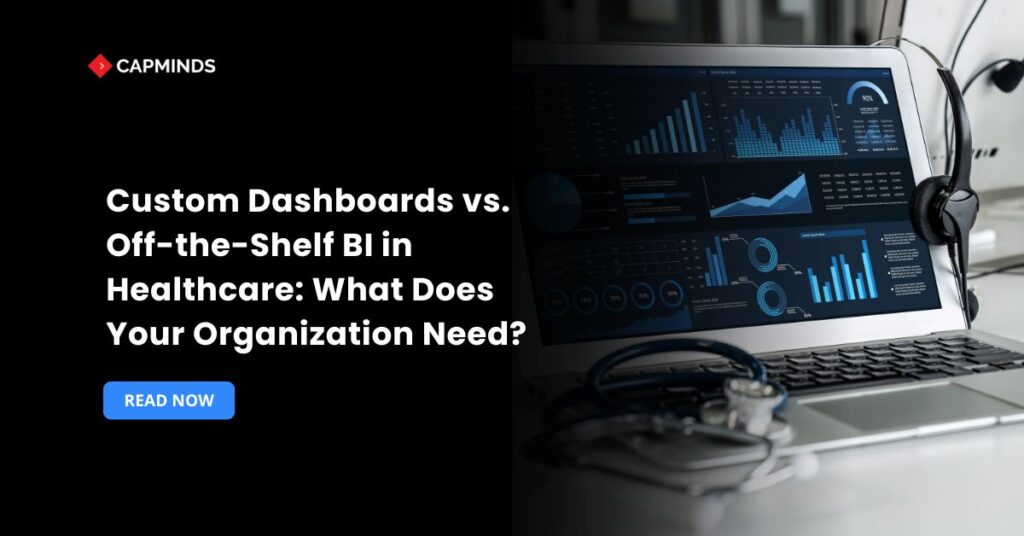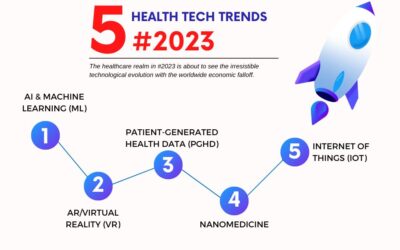Custom Dashboards vs. Off-the-Shelf BI in Healthcare: What Does Your Organization Need?
Healthcare organizations generate massive data daily. Business Intelligence dashboards transform this raw data into visual insights for decision-making. For example, one hospital can produce 50,000 terabytes of data per day; without BI, this information is overwhelming. Many healthcare organizations “drown in data yet struggle to extract meaningful insights,” making effective BI crucial.
Effective BI analytics optimize resource allocation and patient flow, yielding improved efficiency and patient care. Dashboards make this process seamless by flagging bottlenecks and tracking key metrics in real time. BI dashboards deliver these insights continuously, allowing providers to adjust staffing on the fly and catch issues before they escalate.
For instance, BI platforms allow hospitals to monitor patient wait times and staff utilization in real time, directly improving safety and operational efficiency.
Custom Dashboards: Tailored BI for Healthcare
Custom dashboards are BI solutions built specifically for an organization’s unique needs. Unlike off-the-shelf products, they are developed to match the exact workflows, data sources, and KPIs of a hospital or clinic.
The key advantage is flexibility:
- A custom dashboard can incorporate any specialized metric and adapt as requirements evolve.
- It can integrate directly with chosen systems to ensure seamless data flow.
The drawbacks of custom BI include higher cost and longer timelines. Developing a dashboard from scratch can take many months. Custom solutions also require ongoing maintenance and support, either in-house or via consultants, to handle updates and ensure security. This means a long-term commitment of resources and budget.
Off-the-Shelf BI: Ready-Made Analytics Platforms
Off-the-shelf BI tools are pre-built analytics solutions with built-in dashboards and features. They are designed for rapid deployment, often out-of-the-box with no coding required.
Standard visualizations and data connectors come ready-made, which means shorter setup time and lower initial cost. Popular platforms also include vendor support and large user communities for training and feedback.
- For example, many off-the-shelf BI platforms offer free trials and vibrant online communities, allowing organizations to evaluate features before fully committing.
- However, off-the-shelf BI is generally more rigid, limiting users to the vendor’s features.
- As Sigma Infosolutions warns, “cookie-cutter solutions rarely check all the boxes” in healthcare, especially for compliance and integration.
Such tools may lack niche healthcare KPIs or fine-grained controls needed in medical reporting. Over time, subscription fees accumulate, and configuring security and compliance can require significant effort.
There’s also a risk of vendor lock-in: switching platforms later can become difficult and expensive.
Common Use Cases and Scenarios
Healthcare organizations benefit from BI in many areas. Common use cases include:
Regulatory Reporting and Quality
Providers must report metrics to regulators. Off-the-shelf BI may include templates for standard measures, but new or specialized metrics often require custom solutions. Any BI system must produce audit-ready reports to avoid fines.
Operational Efficiency
Hospitals use BI to optimize workflows and resources. Dashboards can reveal patterns so staffing can be adjusted. BI helps “predict patient admission rates, optimize staff scheduling, and allocate medical resources efficiently”. Off-the-shelf BI can deliver many standard performance metrics, while custom dashboards can handle specialized processes.
Clinical and Patient Outcomes
BI dashboards track safety and outcome measures. These insights allow prompt action when quality drops. Off-the-shelf tools cover common clinical KPIs, but custom dashboards can combine data from specific programs for deeper analysis.
Financial and Revenue Cycle
Claims and billing data can be analyzed to improve revenue. Dashboards show claim denials and billing delays. BI analytics have uncovered millions in lost revenue; one system recovered $12 M by identifying revenue cycle inefficiencies. Standard BI products often include financial modules, but organizations may need custom reports for unique payer rules and cost metrics.
Population Health and Public Health Analytics
Health systems and public health agencies use BI to spot disease trends and manage community health. By analyzing EHR, lab, and demographic data, BI platforms can identify patterns and guide prevention strategies.
Off-the-shelf BI can visualize many population health metrics, but custom dashboards may be built to integrate specific public data sources and epidemiological models.
Each scenario has trade-offs. Off-the-shelf BI can cover common metrics quickly and may be sufficient for standard reporting. Custom dashboards excel when workflows or reporting needs are unique.
Some organizations adopt a hybrid approach: using core off-the-shelf dashboards and building custom extensions for specialized needs.
Related: How Custom EHR Dashboards and Reporting Tools Help You Make Data-Driven Decisions
Comparison Table: Custom vs. Off-the-Shelf BI
| Dimension | Custom Dashboard | Off-the-Shelf BI |
| Cost | High up-front development cost; no ongoing license fees | Lower initial cost; ongoing subscription or license fees |
| Flexibility | Highly flexible; tailored to exact needs | Less flexible; fixed feature set |
| Implementation Time | Longer (often several months) | Rapid deployment (weeks); plug-and-play |
| Scalability | Scalable if designed correctly; custom code can handle large data | Typically cloud-based, scales easily with demand |
| Integration | Built to connect specific systems (EHR, billing, labs) | Includes many connectors, but can struggle with niche legacy systems |
| Compliance & Security | Can be built to exact standards (HIPAA, audit logs) | Enterprise tools often have built-in security; compliance must be configured |
| Maintenance & Support | Requires an internal or contracted development team | Vendor provides updates and support |
| Long-term Value | High potential ROI and competitive advantage if the needs are unique | Reliable for standard KPIs; value depends on fit and usage |
Challenges and Risks
Implementing BI in healthcare carries challenges regardless of the approach. Data Integration and Quality: Healthcare data is often siloed in EHRs, labs, and billing systems.
Integrating these sources is a major hurdle, and poor data quality or inconsistent coding can lead to misleading analytics. Both custom and off-the-shelf solutions require careful data cleansing and governance.
Regulatory and Security
Any BI solution must meet HIPAA, HITRUST, and other healthcare regulations. Off-the-shelf tools may require extra configuration to address healthcare-specific compliance.
Custom solutions must build in encryption, access controls, and audit logs from the start. Failure to comply can lead to fines or data breaches.
User Adoption
A dashboard is only useful if staff use it. Both approaches need an intuitive interface and training. Custom dashboards can match actual workflows, which helps adoption, but they still require change management. Off-the-shelf tools may be familiar, but staff must learn to trust and interpret the analytics.
Cost & Maintenance
Custom BI has high upfront cost and development risk; off-the-shelf has ongoing license fees. Hidden expenses can accumulate. There’s also a risk of vendor lock-in: switching platforms later can become difficult and expensive. Both approaches require ongoing maintenance and skilled IT support.
Technical Skills
Custom solutions demand skilled developers and data analysts. Off-the-shelf tools reduce the need for programming, but still require IT support for integration and management. A lack of in-house BI expertise is a risk for either approach.
Overall, healthcare organizations must weigh these risks. Custom BI offers precision but requires robust project management and technical commitment, while off-the-shelf BI reduces initial effort but may need workarounds for unique needs.
Assessing Your Organization’s BI Readiness
Before choosing an approach, evaluate your organization’s current capabilities and goals. Consider:
- Assess current data capabilities: Identify existing systems and any reporting in use. Note data silos and integration gaps.
- Define priorities: Determine key use cases and strategic goals. Pinpoint what insights would drive decisions.
- Budget and timeline: Off-the-shelf BI can be deployed quickly; custom projects require realistic planning and investment. Match your timeline and budget to the complexity of the solution.
- Governance and training: Ensure data governance, security, and staff training. “Even the best BI system fails if staff don’t trust it”, so plan for user education and iterative feedback.
- Leadership and culture: Secure executive support and foster a data-driven culture. BI success depends on leadership buy-in and organization-wide commitment.
- Pilot and scale: Start with a limited rollout and measure success. Expand gradually and consider adding advanced analytics as maturity grows.
By evaluating your BI maturity and constraints, you can choose the solution that best matches your organization’s needs.
CapMinds Healthcare BI & Custom Dashboard Solutions
Unlock the full power of your healthcare data with CapMinds.
Whether you need to streamline reporting, enhance patient outcomes, or gain real-time visibility into operations, our team delivers tailored BI solutions designed specifically for healthcare providers.
At CapMinds, we understand that one-size-fits-all dashboards rarely meet the evolving needs of today’s healthcare organizations. That’s why we offer:
- Custom-built healthcare analytics dashboards
- Business Intelligence dashboard development services
- Seamless integration with EHR, billing, lab, and population health systems
- Regulatory-ready reporting tools (HIPAA, MIPS, HEDIS, and more)
- Real-time dashboards for clinical, operational, and financial KPIs
- Scalable architecture for hospitals, clinics, MSOs, and ACOs
- End-to-end support, from planning to deployment and optimization
Whether you’re upgrading from spreadsheets or outgrowing your current BI tool, CapMinds can build a solution that fits your exact needs.




